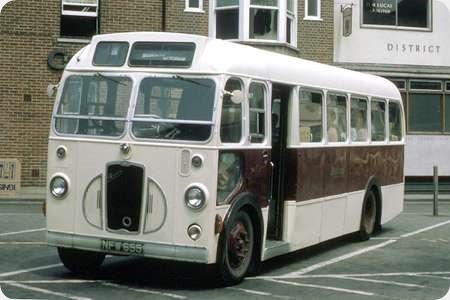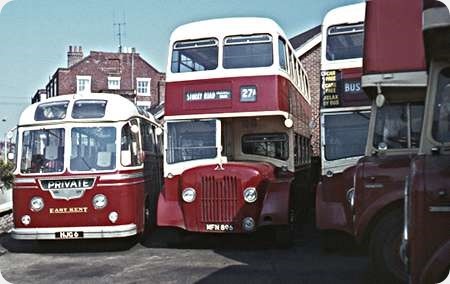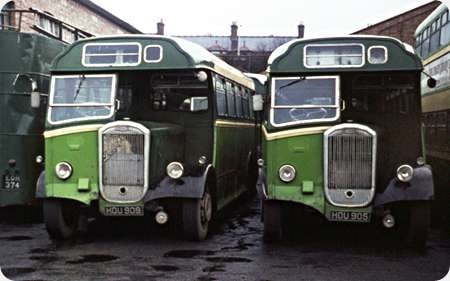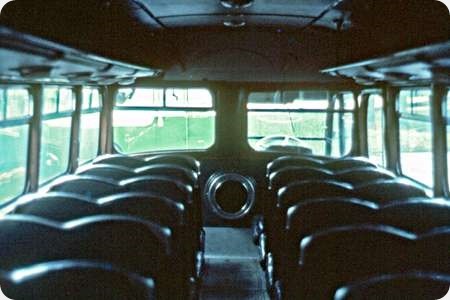R & R Coaches t/a Beeline – Bristol SC4 – NFW 655
R & R Coaches t/a Beeline
1956
Bristol Bristol SC4LK
ECW B35F
The lightweight SC (small capacity) vehicle emerged in 1954 and was the Bristol/ECW offering for BTC lightly trafficked rural bus routes. Every opportunity was taken to save weight. The chassis longitudinal members were simple straight lengths of channel lacking intermediate transverse sections, and the body was sheeted in fairly thin aluminium. The axles were reputedly sourced from Bedford, and the five speed gearbox, with its idiosyncratic selector positioning between third and fourth, came from the David Brown company. Three prototypes were constructed, the first, 724 APU, fitted with the Gardner 4LK engine and classified SCX4G, was delivered to Eastern National in November 1954. This was followed by 725 APU in December 1954, but this had the Perkins P6 engine and was called the SCX6P. This bus later received a 4LK engine in 1958. The third prototype, another 4LK powered SCX4G, went to Eastern Counties in December 1955, and as all subsequent SCs were powered by the 4LK engine, the classification thereafter was amended to the familiar SC4LK. Production, including the prototypes, totalled 323, Lincolnshire being the greatest user with 113 examples, followed by Eastern Counties with 88, Crosville 79, and Eastern National 22. The other BTC companies took the SC in penny numbers only – United Counties 6, Cumberland and Thames Valley 5 each, Red & White 4, and United Welsh just 1. The little 3.8 litre 57 bhp 4LK had to work hard in the SC, a duty not helped by the curious ratios of the David Brown gearbox. The gap between second and third has been noted by a number of commentators, but, in my experience of driving the type, it was the gap between third and fourth that truly restricted progress. This necessitated the revving of the engine to its absolute maximum before attempting to change up, a move that frequently proved abortive so that a change back down again was immediately required. Thus the engine spent much of its time at its 2100 maximum revolutions with a deleterious effect upon the eardrums of driver and passengers alike. The gearbox offered a fifth gear that was only of feasible use downhill or on the level with a following wind. The SC remained in production until 1961, during which time Dennis had been collaborating with Bristol in respect of the Loline, and one wonders if the Guildford company could not have offered the Falcon gearbox, available in four and five speed versions, for the SC instead of the impractical David Brown unit. The picture shows former Lincolnshire Road Car No. 2414 NFW 655, delivered new in May 1956 and sold on in 1969. I photographed it in service in July 1970 with R & R Coaches, Bishopstrowe, Wilts, trading as Beeline. The location is New Canal, Salisbury, formerly a section of the long defunct Salisbury and Southampton Canal which was closed in 1806. This bus was withdrawn by Beeline in May 1972 and its subsequent fate is not recorded. R & R Coaches still exists but it would seem that the company was reconstituted in 1971.
I acknowledge the detailed Bristol Vehicles Website as the source of much information:- //www.bristolsu.co.uk
Photograph and Copy contributed by Roger Cox
08/02/21 – 06:41
I once rode on a Lincolnshire SC4LK from Goole town centre to my lodgings in the town and my abiding memory is that I was glad it was only a short ride on such a noisy and uncomfortable bus.
Stan Zapiec
08/02/21 – 11:57
I’m a dinosaur, Stan, and still think that there is no substitute for cc. Many BTC/THC companies thought the same and, where possible, used an LS5 or MW5 in preference. SC and SU only made sense in the flat lands of Lincolnshire and the Fens – and yet Crosville, United and Western National used them in the Hill Country. There is sometimes no accounting.
David Oldfield
09/02/21 – 06:08
I think it must have been about 1958/59 that I travelled on an SC4LK on Lincolnshire’s route 3 from Cleethorpes to Lincoln on a cold wet January Sunday evening. (No train service on Sundays). The wolds section Ravendale, Binbrook, Kirmond-le-Mire, Tealby is seriously hilly – not your typical Lincolnshire flat lands. The whole trip was a growling/ screaming assault on the ears – about an hour and 40 minutes of it if I remember rightly.
Stephen Ford
09/02/21 – 13:36
We hated these on Eastern Counties. They were very noisy, and rattled everywhere. Plus, to take fares the driver had to swivel right round to the left, and work through the central gap behind. As luck would have it, I joined the Cambridge depot in 1970, and they were soon to be withdrawn.
Norman Long
10/02/21 – 06:19
I’m struggling to visualise how the chassis would work without any intermediate transverse sections, does that mean there were some but only at the front and rear? Presumably the bodywork played some part in keeping the whole thing together but I don’t think these were semi-integral were they?
How would the completed chassis be sent from Bristol to Lowestoft? Would some temporary spacers be inserted?
Chris Barker
14/02/21 – 07:04
Chris, I cannot now recall where I first learned of the simple layout of the SC chassis, but the body structure definitely contributed to the integrity of the entire vehicle. My long held belief was endorsed by Peter Cook’s comment of 02/11/2019 under Eastern Counties – Bristol SC4LK – VVF 540 – 540, and Peter owns one of the type.
Roger Cox
28/03/21 – 07:57
Further to David Oldfield (8/2/21) Western National’s SC lookalikes were actually rebuilt and rebodied L6Bs, which should explain their hill-climbing ability. United didn’t have any SCs, but they did have five SUs.
David Call
29/11/21 – 06:27
Interesting to read the comments here, and mine are similar. We moved to the county of Merioneth in 1971 when I was 9, and our Crosville service was Dolgellau – Machynlleth and return three times a day and none on Sundays. Usual fayre was MW5s which as a young boy I liked. SC4LKs were occasional visitors and I assume one was kept as a standby bus at Machynlleth.
The journey to school was on the Aberllefenni – Tywyn school bus which was contracted to Crosville until probably 1975. Out of season we were treated to a coach, mostly CMG 523 as I remember, but come the summer we had whatever was available at Machynlleth garage – an MW5 or an SC4.The latter were awful particularly when climbing. The return from school involved a hill climb between Abergynolwyn and Talyllyn, then the main climb from the Cader Idris junction up to Upper Corris. Noisy, rattley and generally lacking in stamina are three attributes, but the informative piece explains it all.
I have recently bought an Anbrico whitemetal model and intend to repaint it in Crosville livery as a childhood reminder.
Phil Bartlett
Quick links to the - Comments Page - Contact Page - Home Page





